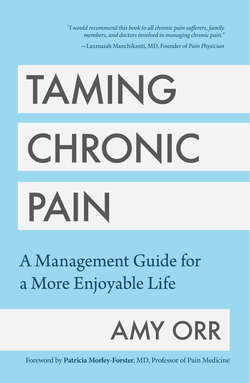Читать книгу Taming Chronic Pain - Amy Orr - Страница 6
На сайте Литреса книга снята с продажи.
ОглавлениеForeword
I was in the middle of a career as an anesthesiologist at a university teaching hospital in southwestern Ontario when I decided to go back to school. I wanted to learn more about chronic pain. I had been an obstetric anesthesiologist, relieving labor pain, and had also dealt with post-surgical pain in recovery and on the surgical floors. Surgical pain is acute pain. Doctors and nurses expect, understand, and know how to deal with acute pain. Usually what works for one patient after a certain surgery will work well to treat others after a similar surgery, with minor variations. But the world of chronic pain is very different, one problem being that what works for one person with a chronic pain condition might not work at all for someone with the same diagnosis. And the patient’s life situation, mood, and past experience with pain are important in working toward pain control.
When I first started working in chronic pain clinics, I was struck by the lack of knowledge, scarcity of research, and general misconceptions around the condition of chronic pain. Here was a problem that one in five people in the United States and Canada suffer from, yet doctors-to-be received almost no training in it at any time in their undergraduate or postgraduate years.
Different medical specialties often held opposing views on how to assess and treat chronic pain. How could a patient experiencing the confusion, fatigue, and life-changing experience of chronic pain make sense of their problem if even their doctors couldn’t? It is so multi-faceted and affects virtually every aspect of life, work, and relationships. Collaborative multi-disciplinary care for the patient, and education for the providers, seemed to make the most sense. Different approaches will appeal to different people.
Doctors do not come off well in Taming Chronic Pain, this recounting of author Amy Orr’s journey of discovering how to live well with her chronic pain. I am happy to say that, in the past ten years, education in pain management has become mandatory in most Canadian and American medical schools. There is even a path to certification in the specialty of Pain Medicine now in Canada, as well as several other countries. In the future, I hope that patients reporting ongoing pain to their doctor will meet with fewer confused looks, and more understanding, than Amy did in her medical journey.
I was very pleased to be invited to write the foreword for this book. I first met Amy in 2014 when I was the medical director of the Multi-Disciplinary Pain Program at St. Joseph’s Health Care in London, Ontario. To Amy, a curious person both by nature and training, this encounter was a revelation. The diagnosis gave a medical name to her sense of “feeling broken,” and set her on the path to discovering everything she could about her condition. She has spent the last few years writing Taming Chronic Pain to explain all she has learned to others who are still trying to make sense of their own experiences.
It is unusual to find a book on chronic pain written by one who experiences it daily. When that person is also a writer and a scientist, the voice speaks confidently to a wide audience. This is not a book describing all current research on various pain disorders. It is a self-guided tour through the multiple aspects of causation, therapy, and self-awareness that an individual with chronic pain needs to understand in order to help themselves.
I was impressed by the work, woven out of Amy’s personal experience and amplified by her thoughtfulness, curiosity, and research. Her style is candid about her own experiences and practical in her advice. The story reveals her struggles, but always guides the reader away from negativity to more positive feelings of choice and control.
Amy’s writing style is conversational and direct, even blunt. Although easy to read, the information cannot all be digested, or applied, quickly. Many chapters end with a practical exercise, which should be read and worked on, time and again, in an effort to perfect the underlying skills they promote.
I think this book is useful for both patients and doctors. It deals with real concerns that clinicians and patients face. For example, I soon learned in the clinic that the available medications played a relatively small role in treatment. Side effects were frequent, the pain-relieving benefits small, and insurance coverage often difficult. In the long-term, self-management strategies play a greater role than medications alone. Many chapters here are devoted to aspects of self-management such as being aware of your personal energy (“Resource Management”), keeping moving (“Exercise and Pain”), and dealing with the inevitable anxiety and sadness (“Anxiety” and “Mindfulness and Meditation”). The chapter “Alternative Therapies” is the most practical guide that I have yet seen to sorting through available options. Interestingly to me, she recommends rating the therapies not necessarily on scientific evidence, rather on how they help the individual feel better.
In the introduction, and in the concluding summary, Amy makes it clear that there is no miracle cure. Rather the key to a better life with pain is to make small changes, little by little. And to become skilled at observing your body’s response. This is the most important message of Taming Chronic Pain, told in such a way as to make it sound brand new. I only wish that I had this book available to me earlier so that I could have recommended it to my patients.
Patricia Morley-Forster, MD, FRCPC
Anesthesiology and Pain Medicine, Founder Status
Professor Emerita
Dept of Anesthesiology and Perioperative Care,
Western University, London, Canada
2013 Canadian Anesthesiologists’ Society Gold Medal Winner
